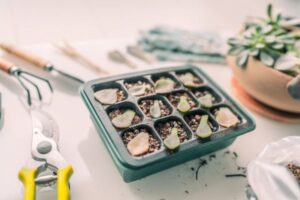As we step into the enchanting world of indoor gardening, we are greeted by a symphony of verdant hues and a tapestry of captivating foliage. The allure of cultivating an indoor garden lies not only in its aesthetic appeal but also in the profound connection it fosters with the natural world. Each plant becomes a living testament to the wonders of life, a delicate reminder of our symbiotic relationship with nature. Amidst this harmonious coexistence, one horticultural practice stands out as a transformative art – pruning. An act of both precision and creativity, pruning is the gentle touch that sculpts and nurtures our indoor plants, shaping them into their most resplendent and flourishing forms.
In this comprehensive guide to pruning indoor plants, we embark on a journey that transcends the ordinary realm of plant care. It is a voyage of exploration, where we unravel the purpose, benefits, and nuances of pruning, delving into the heart of this horticultural masterpiece. Beyond its tangible effects on plant health and appearance, pruning unveils a profound language of communication between caretaker and plant, a silent dialogue of nurture and growth. As we peer into the artistry of pruning, we discover the secrets to fostering a thriving indoor garden, where each plant becomes a living canvas of beauty and vitality.
Understanding the Purpose and Benefits of Pruning
Pruning is not a haphazard snipping of plant parts but a thoughtful and deliberate act that holds immense benefits for indoor plants. The primary purpose of pruning is to promote healthy growth and maintain an attractive shape. By removing dead or diseased branches, leaves, or stems, we prevent the spread of diseases and encourage new growth. Pruning also helps in controlling the size of a plant, preventing it from becoming too leggy or overgrown.
Additionally, pruning stimulates the plant’s natural defense mechanisms, directing its energy towards areas that require attention, such as developing new shoots or producing more vibrant blooms. It also improves air circulation within the plant, reducing the risk of fungal diseases and pest infestations. Overall, pruning is a powerful tool that not only enhances the beauty of our indoor plants but also contributes to their overall well-being.
The Right Time to Prune Your Indoor Plants
Knowing when to prune your indoor plants is crucial for achieving the best results. The timing of pruning varies depending on the type of plant and its growth habits. As a general rule, it is best to prune during the active growth phase of the plant, which typically occurs in the spring and summer months. During this time, plants are better equipped to heal and recover from the pruning cuts, facilitating robust new growth.
However, there are exceptions to this rule. Some plants may require pruning during their dormant phase, which often occurs in the winter months. It is essential to research the specific needs of each plant species to determine the most appropriate time for pruning. Regularly inspecting your indoor plants for signs of overgrowth, dead or yellowing leaves, or weak branches can also indicate when pruning is necessary. By timing your pruning sessions strategically, you can ensure that your indoor plants thrive and maintain their optimal appearance throughout the year.
Tools and Techniques for Pruning Indoor Plants
To execute successful pruning sessions, having the right tools and understanding proper techniques is vital. A sharp and clean pair of pruning shears or scissors is a must-have for precise cuts that promote faster healing. For larger branches or thicker stems, handheld pruners or loppers may be required. It’s essential to keep your pruning tools sanitized and sharp to prevent the spread of diseases between plants.
When pruning indoor plants, it’s crucial to make clean and angled cuts just above a node or leaf junction. This method helps the plant heal more efficiently and encourages new growth from the desired location. For thin and leggy stems, pinching off the tips can promote branching and a more compact growth habit. When removing diseased or dead plant parts, always cut back to healthy tissue to prevent further issues.
Some indoor plants, such as certain types of ivy or trailing vines, benefit from more aggressive pruning to maintain a tidy and bushy appearance. Others, like woody or flowering plants, require selective pruning to remove damaged or crossed branches. Understanding the specific needs and growth patterns of each plant species will guide you in applying the appropriate techniques and achieving the desired results.
Pruning Different Types of Indoor Plants
Different types of indoor plants have unique pruning requirements. Foliage plants, such as philodendrons and pothos, often benefit from regular pruning to encourage bushier growth and prevent legginess. For these plants, pinch back the tips of stems or cut back leggy growth to a healthy leaf node.
Flowering plants, like orchids and African violets, require careful pruning to enhance their blooming potential. Remove spent flowers and old flower stems to redirect the plant’s energy into producing new blooms. Trimming back excessive foliage can also allow more light to reach the flowers, encouraging their development.
Woody indoor plants, such as ficus or rubber plants, may require pruning to shape their growth or remove crowded or damaged branches. Be cautious with woody plants, as excessive pruning can lead to shock and slow recovery. Limit pruning to a few branches at a time and allow the plant to recover between sessions.
Trailing or climbing plants, such as pothos or philodendrons, may need regular pruning to prevent them from overtaking their support structures. Trim back long, unruly stems and train the plant to grow in the desired direction by guiding the stems along trellises or support poles.
Aftercare and Maintenance Following Pruning
After completing a successful pruning session, providing proper aftercare and maintenance is essential to ensure that your indoor plants recover and flourish. Water the pruned plants appropriately, keeping in mind that some may require a little extra hydration during the healing process. Consider adding a diluted fertilizer to support new growth and boost the plant’s overall health.
Monitor the pruned plants closely for signs of stress or potential issues. Watch for wilting or yellowing leaves, which may indicate that the plant is struggling to recover. Adjust the lighting and environmental conditions as needed to provide optimal conditions for healing.
Continue to maintain regular care for your indoor plants, including watering, fertilizing, and pest control, to support their growth and well-being. As the plant responds to pruning, observe its development and adjust future pruning sessions accordingly to maintain the desired shape and size.
Conclusion
Pruning indoor plants is an artful practice that rewards us with healthier, more attractive, and thriving botanical companions. Understanding the purpose and benefits of pruning empowers us to wield our pruning shears with precision and intent, creating an environment where our indoor plants flourish and radiate beauty. By timing our pruning sessions thoughtfully and employing the right tools and techniques, we ensure that our green companions receive the care they need to thrive year-round.
As we embrace the diversity of indoor plants and their unique pruning requirements, we cultivate a harmonious relationship with nature within the confines of our homes. Each pruning session becomes an opportunity to connect with our botanical charges and witness the transformation of their growth. By providing proper aftercare and maintaining regular maintenance, we nurture the bonds we share with our indoor plants, fostering an environment of growth and abundance.
As you embark on your pruning journey, let curiosity and observation guide your hands, allowing your indoor garden to bloom with renewed vitality and beauty. Embrace the therapeutic nature of pruning, as you witness the resilience of nature in the rejuvenated growth and flourishing health of your indoor plants. With each precise cut, you not only shape the appearance of your green companions but also create a living canvas of botanical wonder that elevates your living space and enriches your life.



